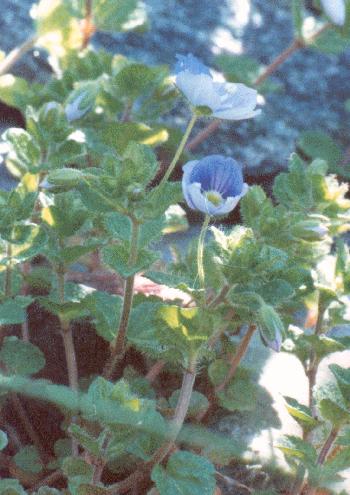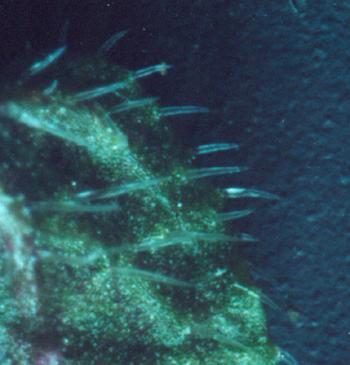Filiformis means 'of fine threadlike structure'. My flower stalks, each solitary from the terminal leaf axil of a creeping shoot, are 15 mm long but barely .2 mm in diameter. The pistils are even more slender, 4 mm long but barely 30 Ám in diameter. (That's less than 1/3 the thickness of normal writing paper.)
Called slender speedwell by some, it is rare in the Ottawa District, as it is not winter hardy here. Originally from Asia Minor, it is cultivated, and now widespread and naturalised, in Europe. It has been sold in North America as a rock garden plant since the 1920's. A perennial, it prefers a fertile and only moderately sunny environment. It is a sterile plant; its flowers apparently do not set seed. However, there are preformed roots at every node, even young ones. Roots appear from a cutting in less than a week, and grow vigorously. It is, therefore, spread by the physical dismemberment of grass cutting, and is considered a problem weed in turf by some.
It also appears to suppress the growth of grass. Not a single blade is visible in the area it covered last fall, although there was solid grass there last spring. This spring, it was still rooted only at one point. It's growth is not dense enough to stop grass growing by shading. New growth, snaking through surrounding grass, does not seem to affect anything.
However, suggestions that chemicals produced by one plant actively suppress the growth of other species have been spurned by botanists for many years. Such effects were 'obviously' due to a lack of knowledge of nutrients in the soil. An impossible standard of proof was demanded of those who suspected otherwise. As a result, very little work has been done in this area. (No such inhibitions can be found where suppression of animals or insects by plants are concerned - c.f. the herbivore defenses of Senecio.)
Some cases involving exudations from roots are accepted, notably by walnut trees (Juglans spp.). But, I have found only two cases where it is accepted that something in the leaves of one plant selectively inhibits the growth of other plants. One of these substances, from the leaves of Artemisia absinthium, is a glucoside. It is excreted from glandular hairs on the leaves. Washed off by rain, it stunts the growth of many plants for up to a meter around. And, the dead leaves virtually eliminate competing growth under the plant.
Veronica leaves contain many glucosides, and V.filiformis contains at least one unusual one. And, the undersides of its leaves are covered with hollow hairs which excrete droplets from their ends. They are about 25 Ám in diameter at the base and 3-5 mm long. They don't squirt when squeezed, but slowly ooze liquid from the tip.
Part of the fear of man-made herbicides is the mistaken feeling that 'chemicals' are 'unnatural'. The truth is that a number of plants around us produce chemicals of one sort or another which reduce competition by other plants. I suspect that there must be many more such plants than are currently recorded in scientific literature if something as common and obvious as V.filiformis was not recorded as such until 1989. Work should be encouraged in this area, both for interest in the chemical isolation mechanisms that must be involved, and for a more balanced view of nature.
Some references:
- Sankey, John 1989. Down Grass, Down. Trail and Landscape 23:116-8.
- Chari, V.M., J.Grayer-Barkmeijer, J.B.Harborne & B.G.Oesterdahl. 1981. An acylated allose-containing 8-hydroxyflavone glycoside from Veronica filiformis. Phytochemistry 20:1977-9
- Harris, G.R. and P.H.Lovell. 1980. Growth and reproductive strategy in Veronica. Annals of Botany 45:447-458. Adventitious root formation in Veronica spp. ibid 459-468
- Audus, L.J. 1959. Plant Growth Substances. Leonard Hill, London. especially pages 394-5
- Bonner, J. 1950. The role of toxic substances in the interactions of higher plants. The Botanical Review 16:51-65. (3-acetyl-6-methoxybenzaldehyde from Encellia farinosa, a glucoside absinthin from Artemesia absinthium)
- Uva, Neal and DiTomaso, Weeds of the Northeast, 1997

the flower and leaves

the glandular hairs